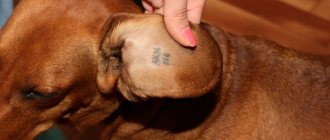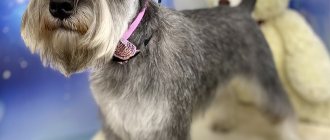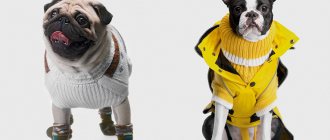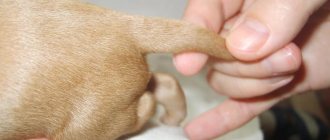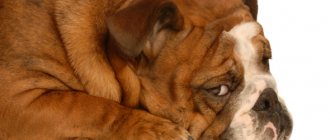Should a purebred puppy have a brand?
- Should a purebred puppy have a brand? It is customary to brand puppies from purebred producers, i.e. give them a tattoo of 3 letters and numbers - this is the requirement for all club owners registered in the RKF. All large cynological communities have their own branding base, but a single one does not yet exist in Russia.
- Sometimes owners of dogs (not taken from a club or kennel) brand their puppies at their discretion. Most often - a telephone number to call if you suddenly find a lost animal. Of course, this cannot be called full-fledged branding, but it is quite possible to identify the animal this way.
Popular questions
Our dog has no documents, she is a mixed breed. Can we brand it in case of loss or is this impossible?
If your dog does not have documents, it does not matter whether it is a mixed breed or a purebred, then it does not have a brand number. The only option that can be used in this case is a stamp in the form of the owner’s phone number. We bought a puppy from a kennel with a brand, but with age the brand stretched and became unreadable
Is it possible to somehow update the brand?
We bought a puppy from a kennel with a brand, but with age the brand stretched and became unreadable. Is it possible to somehow update the brand?
Yes, if you have documents for the dog, the brand can be renewed
What determines the quality and durability of a brand?
It depends on the experience of the specialist who brands the puppy and on how high-quality equipment and paint he uses when working. Therefore, if you want a beautiful and durable brand, it is better not to save money and not look for a “cheaper” type of master (a novice master will most likely be cheaper), but to give preference to a person who has been branding puppies for many years and has positive reviews from previous clients .
We found a dog with some letters and numbers in its ear - what does this mean?
This is a stigma. The first part of the brand, the letters (usually there are 3 of them) - indicate the club/kennel in which the dog was born, and the numbers are the sequential number. For example, the number 129 in the brand will indicate that this is the 129th puppy born and registered in this club.
Neighbors found a dog with the OKBS brand + numbers, which club/kennel may this brand belong to and how to find the dog’s owner?
According to the database, this mark belongs to the Moscow Kennel Club “BIS”. You need to contact the club’s dog handlers, explain the situation and give the full number of the brand, so that they can use the club’s database to check which puppy was assigned such a brand, and if the breed/sex/color you named matches those listed in the database, find the owner’s contacts.
Is a brand given to a puppy at a young age different from a brand given to an adult dog?
Yes, they will be different. The mark placed on a small puppy (especially if it is a large breed puppy) may change with age. The puppy grows, the skin stretches, the mark will also “grow” along with the puppy and become a little paler. A brand made on an adult dog for the purpose of deception, for example, will remain as bright and clear as if it was done just yesterday.
Video
https://youtube.com/watch?v=Z4lAobOYd7g
Sources
- https://www.iku.ru/chto-takoe-klejmo-dlya-sobakhttps://forumosobakah.ru/page/zachem-sobake-kleymohttps://v-mire-sobak.ru/uslugi-dlja-sobak/ klejmenie-sobak.htmlhttps://tattoo-dog.jimdo.com/frequently-asked-questions/
Why do they put brands on puppies and dogs?
- Puppies are branded so that they can be identified before breeding and compared with the data indicated in the pedigree.
Dog identification
- Sometimes life situations arise when without a brand it would be quite difficult to recognize a dog. For example, using the brand code, you can easily find a specific puppy among its brothers and sisters. This is a huge plus for the buyer who has chosen this particular puppy and has already paid money for it.
- A purebred dog may accidentally get lost or be stolen - and then evidence that it belongs to you will immediately become visible.
If it happens that the dog gets lost, then in your advertisements asking for its return you should not indicate its personal code, but only inform that it is available. This will help you find out whether your pet ended up in the hands of the finder, and whether the person is trying to fraudulently lure money out of you by knowing the stamp code.
- However, a brand is not a panacea , and you shouldn’t delude yourself too much about the fact that a dog will be found based on it. Dog handlers are a different matter, but ordinary people are unlikely to see it at all. In addition, over the years it can become barely noticeable.
- And if the owner is preparing his dog to participate in exhibitions , then the mark needs to be clear and clearly visible.
Popular questions
Our dog has no documents, she is a mixed breed. Can we brand it in case of loss or is this impossible?
If your dog does not have documents, it does not matter whether it is a mixed breed or a purebred, then it does not have a brand number. The only option that can be used in this case is a stamp in the form of the owner’s phone number
We bought a puppy from a kennel with a brand, but with age the brand stretched and became unreadable. Is it possible to somehow update the brand?
Yes, if you have documents for the dog, the brand can be renewed
What determines the quality and durability of a brand?
It depends on the experience of the specialist who brands the puppy and on how high-quality equipment and paint he uses when working. Therefore, if you want a beautiful and durable brand, it is better not to save money and not look for a “cheaper” type of master (a novice master will most likely be cheaper), but to give preference to a person who has been branding puppies for many years and has positive reviews from previous clients .
We found a dog with some letters and numbers in its ear - what does this mean?
This is a stigma. The first part of the brand, the letters (usually there are 3 of them) - indicate the club/kennel in which the dog was born, and the numbers are the sequential number. For example, the number 129 in the brand will indicate that this is the 129th puppy born and registered in this club.
Neighbors found a dog with the OKBS brand + numbers, which club/kennel may this brand belong to and how to find the dog’s owner?
According to the database, this mark belongs to the Moscow Kennel Club “BIS”. You need to contact the club’s dog handlers, explain the situation and give the full number of the brand, so that they can use the club’s database to check which puppy was assigned such a brand, and if the breed/sex/color you named matches those listed in the database, find the owner’s contacts.
Is a brand given to a puppy at a young age different from a brand given to an adult dog?
Yes, they will be different. The mark placed on a small puppy (especially if it is a large breed puppy) may change with age. The puppy grows, the skin stretches, the mark will also “grow” along with the puppy and become a little paler. A brand made on an adult dog for the purpose of deception, for example, will remain as bright and clear as if it was done just yesterday.
How to check a puppy for the RKF mark?
The metric, pedigree and all other documents of a particular individual include the number code of the mark, which helps to quickly identify it.
- If doubts arise about the purebred of the dog being purchased and the authenticity of the pedigree provided, then they can be dispelled with the help of the same mark.
- It can also be used to identify the dog's owner if the animal gets lost.
- And if your four-legged friend is microchipped, then finding him will not be difficult. The chip data is located in a single RKF database , so its location can be determined almost instantly - of course, if you have access to it.
You can check it in the database
- Using the number (it must be identical on the animal’s skin and in its measurements), you can detect a substitution when buying a puppy.
- And yet, without a puppy’s brand, it would be very difficult for breeders to carry out breeding selection without making mistakes when reproducing the offspring of elite dog breeds.
- When purchasing a puppy, a bilateral purchase and sale agreement must be drawn up, where the alphanumeric code of its brand will be entered. And if your pet will participate in exhibitions in the future, then all documentation for it will be carefully checked to prevent substitution.
Why microchips?
For decades, animal identification has been done through branding and tattoos, which have a number of disadvantages:
- branding is an extremely painful procedure for the animal;
- over time, the tattoo may become distorted, fade or become overgrown;
- If necessary, the stamp can be faked.
Along with the development of information technology, the problem of animal identification has now been solved with the help of microchips.
Registration of dogs and cats is carried out one month from the date of purchase of the animal. In puppies and kittens, as a rule, it coincides with the first vaccination.
It is important to consider that in order to travel to some countries, microchipping is required on the same day as the rabies vaccination (2nd vaccination). Only those clinics that have the appropriate permits have the right to register and vaccinate animals.
When chipping and registration, the data is entered into a special journal and the animal’s veterinary passport, which also includes information about vaccinations, deworming and treatment against external parasites. This passport serves as the basis for issuing veterinary accompanying documents (for the departure of animals). Such requirements, first of all, should exclude the transportation across the border of animals that may be infected with various infectious diseases, including rabies, and also reduce the risk of substituting one animal for another during transportation
Only those clinics that have the appropriate permits have the right to register and vaccinate animals. When chipping and registration, the data is entered into a special journal and the animal’s veterinary passport, which also includes information about vaccinations, deworming and treatment against external parasites. This passport serves as the basis for issuing veterinary accompanying documents (for the departure of animals). Such requirements, first of all, should exclude the transportation across the border of animals that may be infected with various infectious diseases, including rabies, and also reduce the risk of substituting one animal for another during transportation.
International veterinary passports and vaccination certificates for dogs and cats.
First of all, registration is necessary for owners of animals who travel frequently, since from January 1, 2010, the import of unchipped animals into the European Union is prohibited. An important aspect in favor of chipping is the individuality of identification. Participation in exhibitions and breeding events is also possible only on the basis of a chip number that complies with the ISO 11784/85 standard, entered into the International Database
The presence of an electronic chip is extremely important to prevent the substitution of elite animals at exhibitions and during travel within the country
Other benefits of microchipping:
- The presence of a microchip in animals allows for a simpler accounting system in veterinary clinics, in which medical records and preventive measures for each animal have numbers corresponding to the microchip number.
- Electronic identification can significantly facilitate the search for the owner in the event of the loss of an animal. Chipping helps the owner find a pet if it is lost, and if someone else’s animal is found, you can always easily determine the coordinates of its owner by contacting a specialized local or Internet database.
- Microchipping is a strong argument when disputes arise regarding the ownership of a particular animal.
- In many countries around the world, control and monitoring systems have already been created based on animal microchipping.
- Environmental organizations use an identification system to control the migration of wild animals.
How are puppies branded?
- Before branding, the specialist removes the animal’s fur in the required place (ear or groin) - then the quality of the tattoo will be much higher. After disinfecting this area, a stamp cliche - a gel pen is used for this. And only then, according to this template, a brand is applied to the puppies, which is not subject to washing off.
- To do this, use special tools - a pen marker or a glue gun.
Dog branding machine
- In a pen-type kleimator, although it is externally similar to a fountain pen or a modern pencil, in which the rod extends, there is a significant difference - a needle.
- The tattoo ink is held in a container inside the tool and when the needle moves, it is released into the tip of the needle. For tattooing dogs, use only black tattoo ink. With one piercing of the skin with a pen-claymator, 1 tattoo point is created.
- in the design of clamping pliers . This is a kind of stamp on which the required alphanumeric combination is selected. The symbol on the stamp is studded with needles that pierce the skin of the animal - most often the ear. Then a special tattoo paste is rubbed into these pinpoint wounds. And then it will take a few days for it to dry and crumble, leaving only the pierced points.
Application technology
Let's look at this in more detail and find out what makes it special. Answering the question of how to find a dog’s owner using a brand, it is necessary to say a few words about existing methods of applying an identifier. As mentioned earlier, this requires specialized equipment.
Today two tools are used:
- Claymator pen. In appearance, this device is very similar to an ordinary pencil that children use to draw. Instead of a rod, it has a needle. There is also an ink ampoule inside. Rotary pens are the most popular because they are much easier to work with and the operation takes less time.
- Claimator-tongs. This device is based on a completely different algorithm. It has a special panel consisting of needles on which an alphanumeric code is typed. When the tattoo is inked on the animal, the wounds are filled with ink, the excess of which simply falls off after a certain period of time. The readability of the identifier depends on the quality of the device, as well as the level of qualifications and experience of the veterinarian.
At the very beginning, the area of skin on which the brand will be applied is shaved bald. The procedure lasts only a few minutes, so the animal does not have to suffer for long. The pain of the operation depends on the individual characteristics and sensitivity of the puppy. After completing the procedure, the alphanumeric code is entered into the database and entered into the documents for the animal. Also, the nursery staff advises the owner in detail on how to find the dog’s owner using the brand.
It is very important that all hygiene rules are followed when applying a tattoo. Otherwise, there is a high probability of introducing any infection into the animal’s body.
How are puppies branded?
- The puppy is usually branded either by specialized specialists or veterinarians. This operation is trusted to be carried out by experienced people who do not necessarily have special education.
- A specialist who is already well-trained can conduct a branding session quickly, practically painlessly and safely. In general, such an operation should be the prerogative of a veterinarian, but at the same time he should also be a stigmatizer.
- Since such veterinary clinics are rare, canine organizations often employ people trained in this craft, and not necessarily veterinarians.
- If there is a need to update a brand that is difficult to see on an animal’s body or to give the dog a tattoo (for example, the owner’s telephone number), then for this you can find out at the club or kennel who you can contact for qualified help. There are also private branding machines, information about which is abundant on dog lovers’ forums.
Procedure
After receiving the number from the RCH, the puppy needs to be prepared for tattooing. You can apply the ID at home if you have sufficient skills, or you can contact a specialist.
First of all, the area around the future tattoo is cleaned, excess hair is shaved off, and the area is disinfected. The procedure itself takes no more than fifteen minutes. Some methods can reduce branding time to four to five minutes.
For puppies, such a procedure is almost painless, but this does not mean that they will not try to dodge and escape. The pet's paws and body should be firmly fixed to provide the specialist with free access to the working area.
At what age is it best to carry out branding?
You can get a tattoo on an animal at any age. And yet puppies are branded at the age of a month and a half. The most common age is forty-fifth day after birth. It is worth noting that a puppy is much more tolerant of branding than an adult dog.
Read Everything you need to know about metrics for a puppy
Where is the mark placed?
Dogs are most often branded on the ear. They are also placed either in the groin area, on the inner thigh or on the stomach.
What is a puppy's metric and brand?
- The person who affixed the mark confirms the procedure he carried out, i.e. he must sign on a special card, which is called “general litter” . Next, the breeder and inspector sign a document confirming the examination of the puppy litter. This happens if absolutely every puppy is branded with its own number and coding. They are included in puppy registration and other breeding documents.
A metric is issued
- This data is needed so that you can always find out where the dog comes from and who is its legal owner (if the breeder retains documents confirming the act of purchasing the animal). In addition, nickname, date of birth, coat color, etc. - all this can be easily found out using metric information.
- The brand of a puppy is like a human passport. It includes letter and number individual sets. The area where the tattoo will be applied is first cleaned to protect the animal from infection. And after that, in fact, they begin to apply the mark.
- By registering with the RKF, all kennel clubs and kennels receive their own letter sets in order to brand litters with this code. A code of three or four letters is assigned to the four-legged babies one by one. It is these letters that are like a “business card”, by which you can always find out where the pet was taken from.
- Also, dogs have a numerical code in their brand, which breeders choose independently. It can also be supplemented with letters; it is permissible to use a fractional line.
- After applying such a unique tattoo, the dog’s “personality” can always be established.
Sign or object?
The term “stigma” did not arise today, or even yesterday. It was first used by ancient slave traders and cattle breeders, for whom the mark was a kind of sign of the quality and belonging of an animal or slave to a specific owner.
Brand on an animal
The ancient world was vast and densely populated. It was easy for a person who was captured to hide in the camp of his enemies and flee to his homeland. It was impossible to track the movements of captive slaves. To protect themselves, and at the same time to show their superiority over defeated enemies, the practice of branding was introduced.
A special mark containing letters or a drawing was applied to the human body using a special tool, allowing him to be identified as a slave. It was this mark that was called the brand. Wearing it was shameful, since it equated a person with animals, which were also marked with similar marks.
Over time, the mark appeared not only on the body of slaves, but also on criminals and adulterers. In the latter cases, the location of the mark depended on the crime committed. So, if a slave usually had a mark in the shoulder area, then guilty people were marked on the face and forehead. Each mark was unique, so the escaped person was easy to find.
Branding people in the modern world is illegal, because the brand can only be found on animals or objects. As before, the presence of a mark allows one to judge whether an object or animal belongs to a specific person or manufacturer. Most often, a stamp can be found on jewelry - this is the so-called hallmark or quality mark.
Branding tool
Is it necessary to treat a puppy's brand?
- Puppies will not need any special procedures for processing the brand in the future; a specialist will take care of safety measures. He will remove the hair where it should be and apply an antiseptic solution to his skin.
- And if he uses a spray containing novocaine, then your puppy will not experience the slightest pain and will immediately return to his normal life. The only requirement for the owners is that this place cannot be wetted with water for 7 days after branding .
You can bathe the puppy only a week after branding.
What is it for:
Purpose of branding. The brand makes it possible to identify the dog at exhibitions and, in case of its loss, can help in the search. Insurance companies also require a clear stamp or microchip. The RKF and similar organizations maintain a database. By contacting there, you can find out the kennel to which the series belongs and, using the stud books, restore the number and identify the dog. Using a tattoo, you can completely identify the dog, for example, to identify false pedigrees. The brand is a guarantee to the buyer who has chosen a branded puppy from the litter and left an advance payment to the breeder that in a couple of weeks the puppy will not be intentionally or by mistake replaced with its littermate. In addition, according to the rules of the Russian Canine Federation, the export version of the pedigree, which is necessary for selling puppies abroad and traveling with the dog to exhibitions in other countries, is issued only for branded dogs. The brand is a guarantee of the purebred puppy. In case of loss of documents for a dog, dog handlers will be able to identify it and issue documents again. Many owners stock up on special dog collars engraved with the owner's name and phone number. However, these collars can be lost or removed. The only way to identify a lost or stolen dog is to stamp it.
Is it possible to fake a brand for a puppy?
- Some swindlers, in pursuit of profit, are ready to go to great lengths, including forging the brand of puppies.
It should be remembered that the stigma of a one and a half month old puppy and an adult will vary greatly. As the animal grows older, the tattoo becomes blurred, and over the years it can be almost completely erased. If it was forged on a dog that is old enough, the brand will retain a bright and clear appearance - pay special attention to this when purchasing an animal.
- A tattoo can tell more about a dog's age than anything else. The older she is, the paler her color becomes.
- All clubs and nurseries have stud books or created digital databases where you can find its owner using the dog’s alphanumeric code. And ask him if this is really the same dog that belonged to him and whether it is worth making a dubious purchase.
Troubleshooting the clutch drive
As a rule, when one of the signs of a clutch drive malfunction appears, it is necessary to accurately determine the malfunction. If the problem is in the clutch mechanism, it is better to change the entire clutch kit, and not limit yourself to just the part that has failed.
It is also necessary to take into account the high cost of repair work, since it is often necessary to remove not only the clutch itself, but also the gearbox.
Methods for eliminating some clutch faults:
If problems with operation and a tight clutch pedal remain after repair, we can identify a number of other reasons why the clutch is tight. Among them are:
- clutch cable wear;
- dirt, corrosion in the cable jacket;
- lack of lubrication on the clutch fork shaft.
If we are talking about a hydraulic clutch drive, then the reasons may be a malfunction of the clutch master or slave cylinders.
Let us also add that it is important to replace the clutch release fork as a complete set with the clutch assembly when it becomes deformed or worn out. If this is not done, the plug may burst or bend during operation.
How much does a puppy brand cost?
- There is no clear estimate of the cost of dog branding work - it varies from 150 to 500 rubles. It should be taken into account that the cost of this procedure may vary slightly in different regions; the experience of a professional also has its price.
- If a specialist, at your invitation, comes to your home to brand the puppy, then the price will be different - from 500 rubles. The further the place where the puppy is kept from the person (organization) providing such services, the higher the price for branding will be.
Are you just thinking about buying a puppy? Then we advise you to read the following articles to decide on the breed:
- Cane Corso - what kind of breed, features
- Dog breed Bichon Frize
- Petit Brabançon dog breed
- Pitbull is a killer fighting dog
- Newfoundland - dog breed
- Top 10 most intelligent and loyal dogs in the world
Attention to documents
If vague thoughts about participating in an exhibition and breeding torment you at the time of choosing a puppy, then immediately ask the breeder what documents the kids have. No excuses should bother you. Mom and dad can be beautiful, sweet and smart. They may have documents that the owners “simply did not finish, did not pay for, ordered, but did not pick up.” Moreover, the owners may have documents on hand for the parents of the puppies, but not for the babies themselves, if the mating was not registered with the club. Since it is impossible to make a pedigree for a dog without the original documents issued for the puppy, all this means one thing: they are selling you a puppy without a pedigree.
Types of branding
There are many situations where a tattoo helped to find a lost animal. In addition, the tattoo provides buyers with the guarantee that they will receive the purebred puppy that they initially chose when inspecting the litter. Also, the branding procedure is mandatory if the dog is planned to be sent to Russian and international exhibitions.
Animal identification is possible in two main ways:
- by tattoo;
- by chip.
The second option is more preferable, since searching for an owner using a dog’s brand takes more time than if an electronic chip is implanted into it. If the animal runs away or is stolen, you can determine its exact location in just a few minutes. However, if breeding purebred puppies is not just your hobby, but also a means of earning money, then applying a tattoo is also desirable, since it can be used to track the dog’s pedigree, which, in turn, will increase its value.
